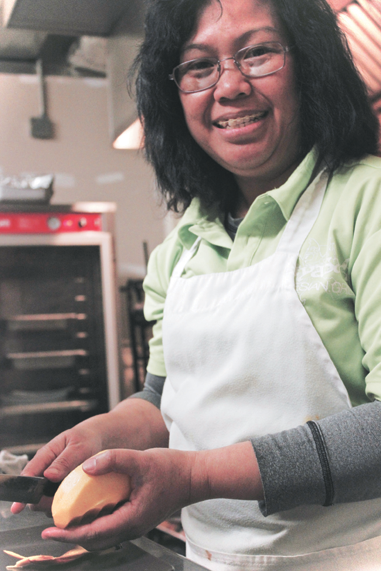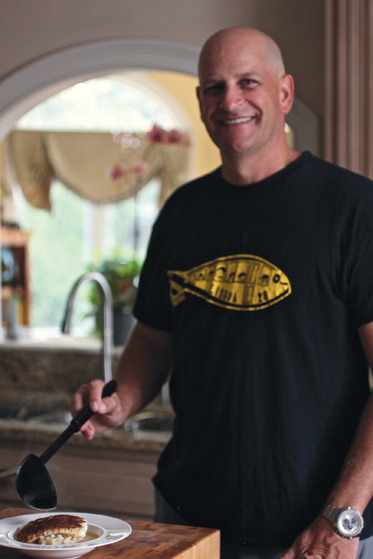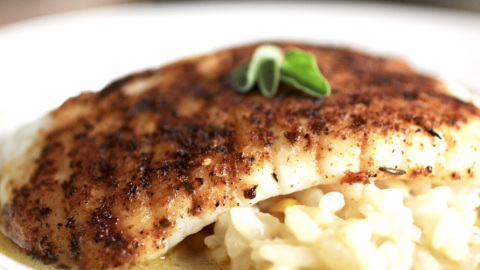Cooks with Heart & Soul
Our stories featured in Cooks with Heart and Soul unite people with a common bond: They all love to cook. What brings people to the table to eat is the same ingredient that brings people to the stove to cook. My friends, it’s the thing that makes us human: heart and soul. And it’s what makes good food so resonate for everyone, no matter your story, past or future. We celebrate these five folks, their love and their heart-warming, living-giving meals. Enjoy. —Colleen Leonardi
The Farmer: Country boy turned country cook.
Pop into Wilson Farm Market in Arcadia over the fall and winter, and you might see a six-foot-two guy in cowboy boots puttering around the kitchen. That’s Scott Wilson, son of the market’s owners and the chef behind the venue’s renowned angel food cake.
Wilson, 41, knows a little bit about failure: When it comes to angel food cakes, there are no guarantees. But he’s nudged his success rate up over the past three years, from about 50% to 85%, by reducing the variables. He reserves one oven for angel food cakes only, stocks up the finest ingredients and mixes everything by hand. “You really don’t know how a cake is going to turn out until you bake it,” he says. Wilson found his recipe through an Amish group of workers who were renovating the market a few years ago. They referred him to one of their mothers, who shared her recipe and gave him some tips. Wilson built upon the recipe, accepting that he might have to fail several times before he would succeed. But today, the cakes are a big hit, whether they’re mixed with apricot, raspberry or just plain vanilla. The cakes retail for $8.99, are preservative-free and taller and lighter than the mass produced cakes.
“People absolutely love the angel food,” Wilson says. “A lot of times they’ll never make the floor once they go into production, because they’ve already been ordered.”
As for those failures, Wilson might try to save them. If half a cake comes out well, he’ll sell it at a reduced price. Or, he’ll eat it. The plain ones are his favorites, although he has a weakness for the crispy parts that spill out of the pan.
Wilson, a self-proclaimed country boy, grew up watching his mother and grandmother throw down wholesome family dinners. Meals were the heart of his family, and young Scott gravitated toward the kitchen to learn more about what brought the ingredients together. Today, Wilson assumes most of the cooking responsibilities for his wife, Amanda, and their blended family of five children. The country boy has become a country cook. A pot of green beans includes smoked sausage, onions and garlic.
“Good cooking can’t necessarily be taught. The wannabe chef needs to have the desire, first,” he says. “Some of my teenagers are beyond hope. I don’t know if I can teach them anything. But our 4-year-old, she’s like I was. She wants to pull up a chair and be at the stove and help."
—Lori Darvas
The Southern Belle: How to make perfect fried green tomatoes.
I loved to bake when I was little,” says Betsy Amirhamzeh. “Always in the kitchen with mama—pies, cakes and oatmeal cookies—every time it snowed.” Which, she says, it did every winter in Greensboro, North Carolina. “Mama said the oatmeal gave us more energy. We’d use extra butter, no raisins, and slightly overcooked them so they’d be crunchy. We followed, more or less, the recipe on the back of the Quaker Oats box.”
A native of North Carolina, Amirhamzeh grew up eating hearty home-cooked meals—the kind of meals that scream Dixie and bring smiles to everyone’s faces.
“Mama cooked every night. I loved, loved, LOVED, her fried chicken with rice and gravy,” she says. “And my grandma’s peach cobbler and baked mac ’n’ cheese and my church’s Brunswick stew that was served every year at our annual fundraiser.”
Today, Amirhamzeh says she cooks those dishes for her family the exact same way her mother and grandmother did, and she still enjoys baking. But over the years her cooking skills have developed, even gotten a bit international.
She met her husband, Arman, in college and after they married she learned to cook a few of the traditional Persian dishes from his home, Iran—dishes like koobideh, an Iranian kebab usually made from beef or ground lamb, and chelow, a golden-brown rice dish similar to a pilaf, only with a crispy crust.
“The kids are always really excited when I cook a Persian meal,” she says.
But, although they love the exotic flavors and textures, her Southern cooking is always a big hit, on any given night. And one of her signature dishes is fried green tomatoes—a Southern favorite even before 1987 novel Fried Green Tomatoes at the Whistle Stop Café and the 1991 movie based on it. I have been lucky enough to try Amirhamzeh’s version and all I can say is, “Towanda!”
Betsy’s tips for making fried green tomatoes akin to the ones served at the Whistle Stop Café:
• Use green tomatoes—really green, no red and no yellow.
• Rinse tomatoes and gently dry them.
• Cut tomatoes into ⅓-inch-thick slices.
For the coating: In one bowl combine equal amounts cornmeal and flour (she uses whole-wheat white flour and cornmeal), and a dash of salt and pepper. In another bowl, combine two eggs with ½ cup milk. Dip sliced tomatoes into dry mix, then wet and then dry again. “To cut the bitterness, a lot of times people sprinkle a little sugar on the tomato before dredging in the flour and egg mixture. The most important thing is to dip the tomato in the flour, then egg and flour again. There has to be a thick coating created.”
Heat canola oil in a cast-iron skillet. “My mama always told me to check if the oil was hot enough before I put anything in it otherwise the tomatoes will turn out burnt and soggy. I put a couple droplets of water on my fingertips and sprinkle them into the oil. If the water pops back up, the oil is ready.”
Layer the bottom of the pan with the tomatoes, making sure they don’t overlap. Fry until they start to brown around the edges.
“Then I flip them and I keep flipping until they turn golden. Once both sides have a nice golden color, remove them onto a paper shopping bag to drain the grease.
“I like to eat them when they’re hot or room temperature. They are fun to dip into a marinara or pizza sauce but I like them just as they are.”
—Shauna Nosler
The Fitness Guru: Fit to eat. Literally.
Carly Dunnuck is not a big fan of the term “clean eating.” The co-owner of Urban Fitness Studio in Bloomington isn’t averse to minimally processed foods and organic meats and produce, but she doesn’t want her clients to think they’re breaking the nutrition law if they occasionally indulge.
“I talk about how we can nourish our bodies and how we can improve our health and our immune system and our digestion,” Dunnuck says.
Dunnuck grew up on 15 acres. If she wanted a snack, she’d go outside and pick it. She’s kept that obsession with fresh ingredients, locally sourced foods and in-season ingredients and tries to instill it in her health and fitness clients. Food is a huge part of staying healthy, Dunnuck says. She learned to cook by watching her mother and, as an adult, watching various cooking shows. Now she cooks for her partner, Rebecca Walter.
Right now, Dunnuck is on a broth kick. During the week, she’ll stash food scraps in a bag in her refrigerator. Onion skins, broccoli stems, leftover herbs and other ingredients go in the bag for safekeeping. When she has a good collection, she’ll roast a chicken, turkey or some other cut of meat. The bones go into a pot with filtered water and her kitchen scraps, and sit on the stove for four hours or more, filling her house with a delicious aroma and creating the broth she swears by. She’ll use the broth for her mother’s chicken soup; as a liquid in stir-fry, quinoa or other grains; or just straight from the cup.
“I love sipping it,” she says. “It is really good after a workout—it’s a little treat. It has collagen. It helps me with fatigue. It helps with digestion. Sometimes I start my day with a little cup of it before I have my coffee.”
Dunnuck relies on local farmers markets and grocery stores for many of her ingredients, changing her menus as the seasons change. A seafood menu in the summer gives way to chicken, bison and pork. Darker greens like kale and roasted fall and winter veggies round out a menu.
When clients ask Dunnuck about making healthier eating choices, she recommends starting with a food journal. Writing down everything they eat helps people identify where they need to make changes. She also recommends eating a good meal before going to a holiday party, to cut down on temptation. Be polite, she says, but don’t be afraid to turn down a holiday treat if it’s not part of your diet.
“Create a script. Tell them it looks beautiful and you’re sure it’s delicious, but you’re going to pass today,” Dunnuck says.
—Lori Darvas
The Islander: Bringing Indonesian family recipes to Greensburg.
Mayasari Effendi was just a child when she started working at her grandmother’s restaurant in Jakarta, Indonesia. She and her cousins would line up and chop onions, “bunches and bunches of onions,” she says.
“We didn’t have daycare or anything like that, so our parents brought us to the restaurant when they worked.” Effendi’s childhood experiences turned out to be a blessing for locals in Greensburg, where Effendi opened Mayasari Indonesian Grill in 2012. There, she shares some of her favorite dishes, like rending daging, a beef curry that can be made mild to spicy depending on the customer’s tastes, and sate ayam, a chicken sate that is a favorite of Effendi’s husband, Richard Mays.
Effendi came to the United States in 2004 to pursue a computer science degree at Purdue University, moving to Greensburg in 2006 to work at Valeo Engine Cooling. When she was laid off in 2009, Mays suggested she take her cooking passion and turn it into a restaurant.
Indonesian food relies on layers of flavor, using local spices like nutmeg, Mays says. The food isn’t spicy like Indian, although patrons can ask for an extra kick when they order off the menu. Instead, it is an intentional combination of spices in an order that lets the flavor build up as it cooks. For instance, Effendi’s chicken sate starts with chicken breasts marinated at least 24 hours. She prepares her peanut sauce slowly, starting with two ingredients and adding additional ingredients one at a time. Each ingredient has its moment to shine before the next is added. The marinated chicken is threaded on skewers, grilled and served with extra peanut sauce for a delicious treat.
As she developed her restaurant menu, Effendi tweaked her recipes to appeal to her American patrons.
“Authentic Indonesian food is very dry and spicy, but I have to be local,” Effendi says. “I have to tweak it a bit to be juicier. Around here they like the gravy. I add coconut milk and more seasoning.”
Effendi tries to buy local as much as she can. Over time, she has developed relationships with local farmers to source her ingredients like tomatoes, bok choy, cayenne pepper, cabbage, carrots and green beans.
She relies on her grandmother’s recipe for tempeh, an Indonesian soy product that produces a tofu-like product. Tempeh starts with soybeans, which are split in half and washed five times. Once cleaned, they are boiled, dried and fermented over a couple of days to become soft and edible. Tempeh can be used as a meat substitute or a side dish.
Even Effendi can’t live on Indonesian food alone, though. Mays says his wife is “a sucker for fried chicken.” Effendi concurs. “Fried chicken,” she says. “I make it myself.”
—Lori Darvas
Mayasari Indonesian Grill
213 N. Broadway St., Greensburg
@MayasariGrill
The Family Man: Cooking for love.
Tim Shefferly, a friend, a husband, a father and, most of all, a family man. His nickname to everyone who knows him is, appropriately, Sheff—the love cooked in his kitchen speaks volumes about who this man is and what he values most. His devotion to food began as a child, watching his mother cook a scrumptious meal after a long day of work. He eagerly anticipated every bite and absorbed every cooking lesson she gave him.
Tim is married to his beautiful bride, Nekko. They have two sons together, Burke and Quinn, and currently reside in Fishers. As a stay-at-home dad, Tim takes his job very seriously making food and nutrition a priority for his family. Mandatory Sunday dinners are opportunities for him to teach his sons how to prepare the meals they eat. The routine of cooking together and sharing meals around the table allows them to share the impacts of their days while building trust and love for a lifetime.
Favorite dishes Tim loves from his sons? Quinn’s farm-fresh scrambled eggs with cheese and Burke’s roasted marshmallow shake, which involves the use of a torch. (What man wouldn’t love that?)
Recently the family took a trip of a lifetime to Portugal. The food and drink there were life changing. “We had a meal at the Michelin- star restaurant Lab by Sergi Arola at the resort Penha Longa in Sintra. Our meal was the best food experience not only I’ve ever had, but my family as well. The flavors and delicate care that went into the preparation of our culinary adventure was remarkable. We gave the kitchen a round of applause as we walked past them.” One of the remarkable dishes was veal sweetbreads roasted in spices with roasted pumpkin purée, carrots and fennel topped with orange and ginger jus. The dish arrived on a small grill plate with smoking chips under it to continue adding flavor—a dish you dream about for the rest of your life.
Tim’s newest infatuation is cooking seafood. His latest recipe? Pan-seared halibut with corn risotto in curry sauce.











